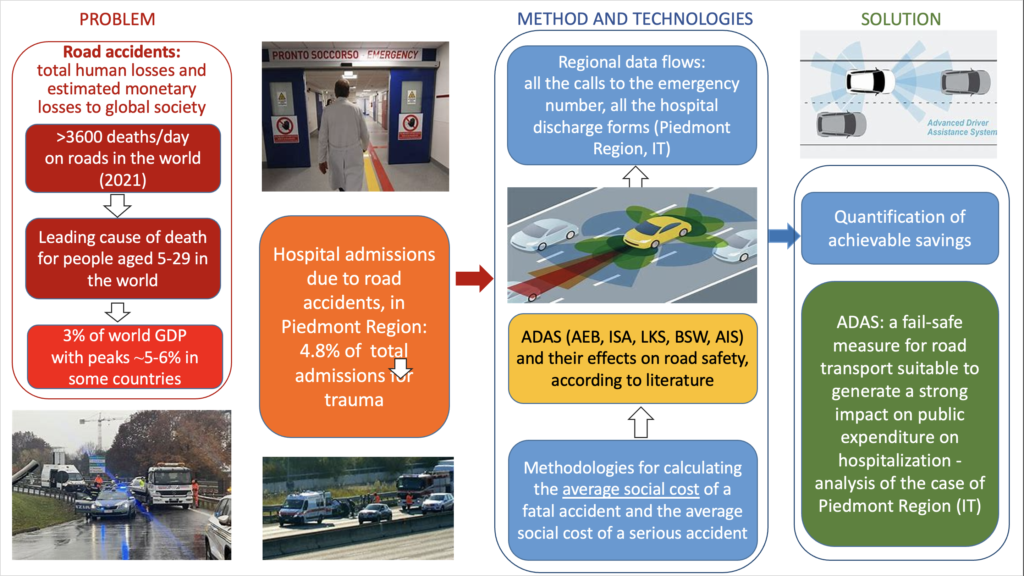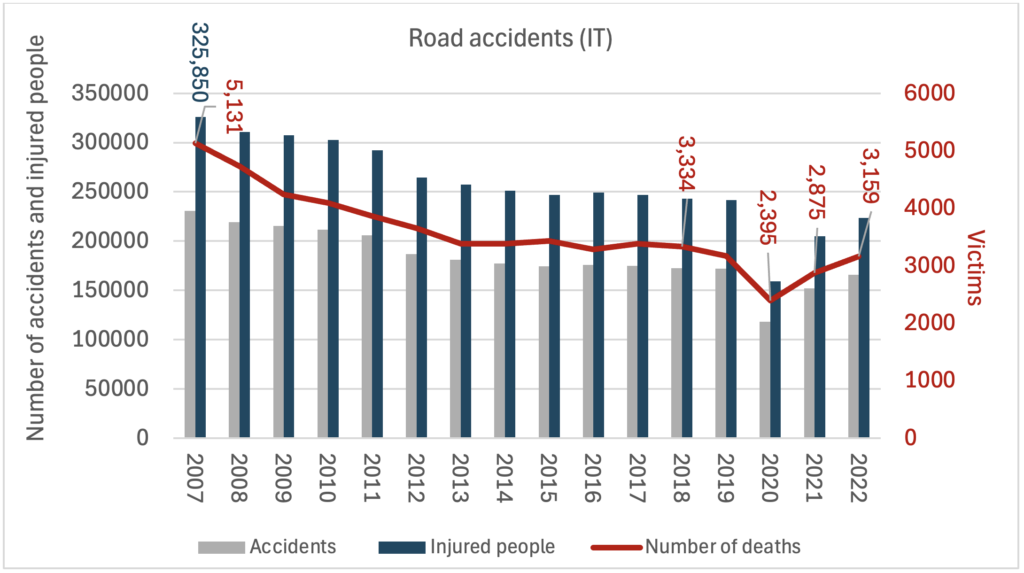This paper is a synthesis of the publication mentioned at the end of it, prepared by one of the authors.
The role of ADAS in regional and national healthcare expenditure
Unlike in previous decades, it is now possible to identify transportation-related technological solutions that make it possible to prevent – and sometimes even avoid – road accidents or at least reduce their severity. These ADAS solutions create a protective layer to mitigate the risk of accidents or reduce their severity. The industrial concept of ‘failsafe’ has now been introduced into road transportation, provided by pre-alert whereas previously safety relied solely on the driver’s alertness, caution and dexterity.
Every day more than 3,600 people die on the world’s roads. More than 40,000 die on European roads every year, with a similar figure in the USA. Road accidents result in over 1.3 million deaths and 50 million injuries annually, placing a significant burden on society and generating substantial economic costs for governments and regions, which are responsible for healthcare expenditure.
In a recent study by two Italian universities (Politecnico di Torino and University of Pavia) and the Regional Health Agency of the Piedmont region in Italy, a novel methodology aimed at quantifying the effects of using ADAS is proposed and applied to a real case, including in economic terms.
The real case consists of the analysis of a very large dataset regarding public health and hospital admissions, made possible by the exceptional access to the internal database, obtained thanks to the health sector of the Piedmont region and the authors’ joint research.
Through selective analysis of the health costs linked to road accidents, it has been possible to quantify the elements considered important for the choices of public decision-makers regarding health and sustainable mobility.
General vision on road accidents, hospitalizations and national costs
What might be the economic effects of the use of ADAS, through the analysis of health-related costs deriving from road accidents?
In 2019, with the Regulation (EU) 2019/2144, the European Parliament made the installation of a package of 30 advanced safety devices mandatory from 2022 for new models, and from 2024 (2025) for existing models. The assumption of a blanket deployment of the different systems will be more likely in the following years.
To identify the expected benefit to the public of the installation of the different ADAS on vehicles, it was necessary to identify, for each technology, the percentage of deaths or injuries that could be avoided by hypothesizing a blanket deployment. This was done by analyzing the state of the art of literature and pulling out the main results for the ADAS under consideration.
In the Piedmont region, the average cost of a hospitalization following a road accident in 2013 was approximately €6,500 (US$7,000) compared with €4,600 (US$5,000) for a hospitalization due to general trauma. In the same year, road accidents accounted for 15% of the total number of injuries due to trauma, which implies that this share can be affected by ADAS; in the following years these values remained quite similar.
Figure 1 synthesizes the analysis process used in this research: from road accidents to hospitalizations, quantifying the role of ADAS for containing costs with an analysis of real data. The whole picture is self-explained while reading the text.

In Europe, road crashes are among the top three leading causes of death, and the leading cause for citizens under 50 years of age.
The repercussions are economic as well as social: to the unquantifiable human tragedy the cost of accidents must be added, which is estimated to be close to 3% of world GDP. Some research shows that considering European countries alone, government expenditure on road accidents is estimated to be around the same value of 3% of GDP. Total expenditure on road accidents in European countries is estimated to be 0.4-4.1% of GDP including the extreme values of different sources.
Over the years, the Italian scenario has been similar to the European one in terms of trend, with a 42% reduction in the number of road deaths in the decade from 2001 to 2010. However, the number of victims in 2019 (3,173), before the reduction in mobility due to the Covid pandemic, was still high and close to a dozen deaths a day on national roads.
The road mortality rate in relation to the population (deaths per million inhabitants) stood at 48.1 in the EU28 and 52.6 in Italy in 2019 (62.8 and 69.4 respectively in 2010).
Since the 1950s, road accidents in Italy had been increasing very rapidly, as analyzed by ACI-ISTAT (2011), which outlines, in the trend from 1950 to 2010, a peak for road fatalities in 1972 (11,078) and with more and more people injured in 2002, then declining thereafter.
The situation is much improved: prevention has yielded considerable results in the last 15 years (Figure 2).

In 2010 there were 211,404 road accidents with personal injury, 4,090 fatalities and 302,735 injuries in Italy (ACI-ISTAT, 2011); in 2019 there were 172,183 road accidents with personal injury in Italy, with 3,173 fatalities and 241,384 injuries (ACI-ISTAT, 2020).
The Ministry of Infrastructure and Transport (2012) defined the methodology for calculating the average social cost of a fatal accident and the average social cost of a serious accident. According to this study, the cost of a fatality is about €1.5m (US$1.6m) and the average cost of a fatal accident is about €1.6m (US$1.7m) (Table 2). The same study also estimated the total national cost of road accidents in 2010 at around €28.5bn (US$30.7bn).
| Severity | Average cost according to severity of injuries [k€] | Average cost according to severity of the accident [k€] |
| Fatal | 1,503 | 1,642 |
| With severe injuries | 0.197 | 0.309 |
| With slight injuries | 0.017 | 0.032 |
| With injuries (no distinction) | 0.042 | – |
Table 2: Cost per level of severity (Source: Ministry of Infrastructure and Transport [2012])
The social cost of accidents resulting in personal injury is gradually and almost constantly decreasing, from €21.4bn (US$23bn) in 2010 to €16.9bn (US$18.2bn) in 2019 (-21%).
For the year 2019 the Ministry of Infrastructure and Transport (2020) estimated on the basis of the same methodology that the social costs of injuries for the year 2019 decreased to €16.8bn (US$18.1bn) (about 1% of the national GDP) (Table 3).
| Total social cost of personal injury accidents (2019) | |
| Average cost for death | €1,503,990.00 |
| Number of deaths | 3,173 |
| Total cost of deaths | €4,772,160,270.00 |
| Average cost for injured | €42,219.00 |
| Number of injured | 241,384 |
| Total social cost of injury accidents | €10,190,991,096.00 |
| Average general costs for accidents | €10,986.00 |
| Number of accidents | 172,183 |
| Total general costs | €1,891,602,438.00 |
| Social cost of injury accidents | €16,854,753,804.00 |
Table 3: Total social cost of accidents involving personal injury (Year 2019) (Sources: ACI-ISTAT (2019); Ministry of Infrastructure and Transport [2020])
The estimate of the social costs of accidents in Italy for 2019, adding to the cost of accidents involving personal injury (€16.9bn/US$18.2bn)) the costs associated with accidents involving property damage only (€6.57bn/US$7bn), amounts to approximately €23.42bn (US$25.27bn).
The road accident data in the Piedmont Region, which has been the subject of interest in this study, has followed the national trend, recording a decrease in the number of accidents from a high of 16,953 in 2001 to a low of 10,646 in 2019 (Piedmont Region, 2020).
The methodology for this analysis aimed at assessing the effects of ADAS on hospitalizations
This analysis has been based on data made available by the Piedmont Region, Health and Welfare Directorate, Department of Health, Essential Levels of Care and Health Building.
As for the choice of the period of analysis, a base of three years has been considered satisfactory: 2017-2019. Despite the possibility of extending the analysis of data to 2020 and 2021, these two years were considered to be completely staggered and offsetting our research, since Covid drastically reduced road traffic and road accidents.
The originality of this work is based on the choice of having elaborated a database, starting from a series of data flows (all the calls to the emergency number 118, arriving at the emergency room, all the hospital discharge forms identified as SDO or schede di dimissione ospedaliera/hospital discharge forms), structured through the use of a special coding (E) present in the SDO according to the international classification of diseases, as detailed hereafter. In particular, the coding E includes all the external causes of injury, some of which concern road accidents.
This analysis was carried out by subdividing the case histories according to the area of the body involved in the traumas. This was done using the Eurocost classification, which allows the classification of injuries according to diagnostic groups with different probabilities of permanent invalidity. In particular, this classification associates with each ICD-9-CM code belonging to a principal diagnosis the corresponding anatomical area to which it belongs. Therefore, this model also appears useful for calculating the costs relating to hospitalization following a road accident.
Two parameters were then calculated for each body district within the Eurocost classification, as follows:
- Average hospitalization: the days of hospitalization that on average are associated with a person admitted to hospital following a road accident;
- Average cost: the economic resources spent on hospitalization.
Through this last parameter it was possible to calculate, by means of a weighted average between the various body areas, the average cost of a hospitalization for a particular type of accident.
Each accident scenario has therefore been associated with one or more driver-assistance technologies which, in the scenario considered, reduce the probability of an accident occurring.
Collision accidents (from literature):
- Automatic emergency braking (AEB) ADAS technology would lead to a 35% reduction in collisions;
- Intelligent speed adaptation (ISA) systems – which acts on the speed factor, which is one of the main causes of accidents, by adjusting it according to the limits imposed on the road section – reduce accidents by 25%. The ISA is also used to prevent ‘accidents due to loss of control’.
Lane departure incidents (from literature):
- Lane-keeping system, avoiding an involuntary change of lane, would reduce the number of accidents by 28%;
- Blind-spot detection devices, thanks to the sensor that detects the presence of another vehicle within the blind spot, can reduce the number of collisions by 20%.
The effect of the alcohol interlock system is cross-sectional, i.e. its effectiveness in reducing road traffic accidents was considered to be positive regardless of the scenario since the risk of road traffic accidents increases exponentially with increasing blood alcohol levels, in addition to extending the overall perception-reaction time. The estimated percentage reduction was 15%. These percentage reductions were then applied to the individual scenarios to determine the economic resources that could be saved, as detailed below.
Results and conclusions
Road accidents lead to a large number of hospitalizations and considerable social costs related to public health, all over the world. The data analysis carried out in this investigation resulted in a minimum saving of €700,000 (US$755,000) and a maximum of approximately €2m (US$2.2m) per year in just one Italian region (Piedmont), on the basis of real data related to hospitalizations following road accidents in the years 2017-2019, before the Covid period, which distorted the trends. This value rises to nearly €5m (US$5.4m) per year if we consider hospitalizations from road accidents related to traumas: if all hospitalizations following trauma are taken into account, the proportion of the total cost due to road accidents is around 7.3%, while accidents accounted for 15% of the total number of injuries due to trauma.
The percentage of admissions following a road accident for the Piedmont region represents approximately 5% of the total admissions for traumas. Contextually, road fatalities in Piedmont, as in the rest of the world, are among the top causes of death: the ninth leading cause of death in all age groups globally and the major cause of death among teenagers. ADAS may have a role in the reduction of deaths and in public health expenditure.
Bearing in mind that the data analyzed in this research does not represent all the rescues and hospitalizations related to road accidents, but only those associated with hospitals in the Piedmont region, it has been possible to provide a cautionary estimation of the real economic impact that this phenomenon has on the health system. However, the fact of being assisted must not constitute an excuse to reduce drivers’ attention and prudence or affect their driving style.
For the complete paper, please refer to:
Basili E, Caschili C, Dalla Chiara B, Pellicelli M, The impact of road accidents on hospital admissions and the potential of ADAS in containing health expenditure: Evidence from Piedmont data, Transportation Research Interdisciplinary Perspectives, Volume 25, 2024, 101125, https://doi.org/10.1016/j.trip.2024.101125


